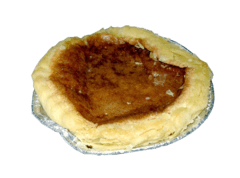Bakewell pudding
| Bakewell pudding | |
|---|---|
| Dessert | |
 A Bakewell pudding | |
| Place of origin: | |
| England | |
| Region or state: | |
| Derbyshire Dales | |
| Creator(s): | |
| Rutland Arms, Bakewell, in 1820 | |
| Serving temperature: | |
| Warm (freshly baked) or cold | |
| Main ingredient(s): | |
| Ground almond, jam, butter, eggs | |
| Recipes at Wikibooks: | |
|
| |
| Media at Wikimedia Commons: | |
|
|
Bakewell pudding is an English dessert commonly consisting of a flaky pastry base with a layer of sieved jam, topped with an egg and almond paste filling. There are numerous variations and several bakeries each claim to hold the original recipe. The pudding originates from the Derbyshire town of Bakewell.[1][2]
Etymology
References to Bakewell pudding appear earlier than the term Bakewell tart, which only appears to have entered common usage in the 20th Century.[1] In 1861, Mrs Beeton published a recipe for "Bakewell pudding" that used breadcrumbs instead of a pastry base.[3] Eliza Acton also makes reference to Bakewell pudding in her book, published in 1845.[4]
History

The origins of the pudding are not clear; however, the generally accepted story is that it was first made by accident in 1820[5] (other sources claim the 1860s)[6] by Mrs Greaves, who was the landlady of the White Horse Inn (now called the Rutland Arms Hotel). She supposedly left instructions for her cook to make a jam tart. The cook, instead of stirring the eggs and almond paste mixture into the pastry, spread it on top of the jam.[7] When cooked, the egg and almond paste set similar to an egg custard, in texture, and the result was successful enough for it to become a popular dish at the Inn. These dates are unlikely to be accurate as the White Horse Inn was demolished no later than 1804[8] to make way for the development of Rutland Square and subsequently the Rutland Arms Hotel.[9] Additionally, Eliza Acton provides a recipe for 'Bakewell pudding' in her book Modern Cookery for Private Families which was published in 1845, making the pudding's creation date of 1860 impossible.[10]
Modern versions of Bakewell tarts are different, both in appearance, flavour and texture to Bakewell puddings. They are generally made by larger commercial bakeries, often with icing on top.[11]
Commercialism

Three shops in Bakewell offer what they each claim is the original recipe. The Bakewell Tart Shop & Coffee House sells four different variations of the confection, including: Bakewell Tart, Iced Bakewell Tart, Moist Bakewell Tart and Traditional Bakewell Pudding;[12] whilst The Old Original Bakewell Pudding Shop and Bloomers of Bakewell both sell a Bakewell Pudding.[13][14]
See also
References
- ↑ 1.0 1.1 "The History of the Bakewell Pudding". Bakewellonline.co.uk. Retrieved 2014-01-18.
- ↑ "Bakewellderbyshire.com". Bakewellderbyshire.com. Retrieved 2014-01-18.
- ↑ Mrs Beeton (1970-01-01). "BBC Food website". Bbc.co.uk. Retrieved 2014-01-18.
- ↑ Eliza Acton (1845). Modern Cookery for Private Families.
- ↑ "Bloomers Original Bakewell Pudding History - Bakewell, Derbyshire". BakewellOnline.co.uk. Retrieved 2014-01-18.
- ↑ Central England (1998-04-18). "One of our famous tarts? I don't think so". Telegraph. Retrieved 2014-01-18.
- ↑ "Rutland Arms Hotel Bakewell". Rutlandarmsbakewell.com. Retrieved 2014-01-18.
- ↑ "Hotel History - - Rutland Arms Hotel". Rutlandarmsbakewell.co.uk. Retrieved 2014-01-18.
- ↑ "Bakewell in Derbyshire". Derbyshireuk.net. Retrieved 2014-01-18.
- ↑ Eliza Acton (1845). Modern Cookery for Private Families.
- ↑ "Mr Kipling Cherry Bakewell tart". Britishdelights.com. Retrieved 2014-01-18.
- ↑ "Bakewell Tart Shop website". Bakewelltartshop.co.uk. Retrieved 2014-01-18.
- ↑ "The Old Original Pudding Company Limited". Bakewellpuddingshop.co.uk. Retrieved 2014-01-18.
- ↑ "Bloomers Original Bakewell Pudding". Bakewellonline.co.uk. Retrieved 2014-01-18.
Bibliography
- Eliza Acton (1845). Modern Cookery for Private Families.
- Isabella Mary Beeton (1861). Beeton's Book of Household Management.
External links
- One of our most famous tarts? I don't think so The Telegraph, 18 April 1998
- Bakewell pudding on About.com